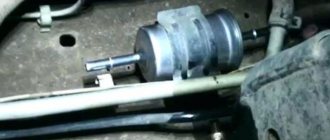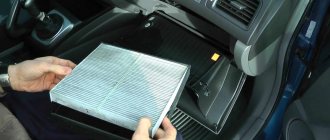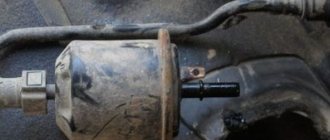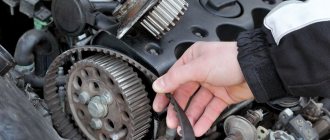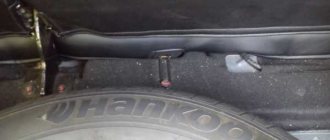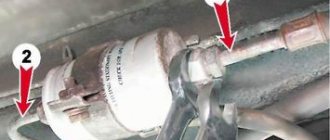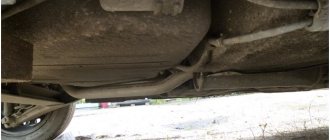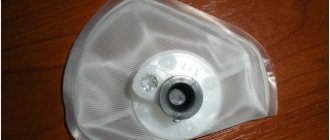The efficiency of the engine depends on the condition of the vehicle's fuel system. The cleanliness of the system determines the dynamics and speed characteristics. Also, the condition of the fuel system has a significant impact on fuel consumption.
Not everyone can see faults in time.
Technical characteristics that decline over time do not particularly affect the driving quality of the car. But some time will pass, and various breakdowns may occur. This is a reflection of the situation with the car's fuel system. It is very important to know the frequency of replacing the fuel filter on a particular car.
Indeed, in these very parts the fuel is purified, which significantly increases the efficiency of the engine. Over time, filters cope with the cleaning task worse.
Causes of typical malfunctions
Many car manufacturers seriously claim that a modern fuel cell can last the entire service life of the car. However, in reality, such a result is simply impossible to achieve. If filters can work for such a long time, then only in a sterile laboratory. The quality of fuel supplied to gas stations in our country is, frankly speaking, low. There may also be various debris found there, which does not have the best effect on the fuel system. So, garbage and dirt are the cause of all problems with the car.
When should a replacement be made?
This question is a bit ambiguous. Today, diesel fuel sold at domestic gas stations does not always meet international standards. The regulations for the maintenance of diesel engines for each car usually indicate the period for replacing the diesel engine every 30 thousand kilometers.
This is what the TF looks like at the installation site
But this figure may vary depending on the quality of gasoline:
- For example, on a Volkswagen Tiguan, the diesel fuel filter can be replaced every 90 thousand kilometers. This is the case if the most important condition is met: when the fuel poured into the car complies with the international standard EN 590. Unfortunately, today it is almost impossible to find such fuel at domestic gas stations, so the time required to change the component is significantly reduced - it will take more time to change often.
- Basically, when a motorist is faced with the question of how long to change the fuel filter, he turns to the service manual. Almost all car manufacturers indicate a figure in their car maintenance books - after 30 thousand km. This means that replacement must be carried out every 30 thousand km if the diesel fuel being filled does not comply with the international standard EN 590. As a rule, such diesel is sold at elite domestic gas stations, that is, where diesel costs a little more than at other gas stations in your area. city.
- There is one more figure - after 7,500 km. If you don’t know how long to change the fuel pump, then analyze the quality of the fuel you filled. The figure of 7,500 km is relevant for those vehicles that use very poor fuel. That is, diesel fuel in which the sulfur content is more than two thousand parts per million. As a rule, such diesel fuel is sold by dealers in low-quality fuel on the side of the road or at too cheap gas stations.
End-of-life diesel TF
On average, given the quality of domestic diesel fuel, a diesel fuel filter should be replaced every 15 thousand kilometers.
However, the above replacement intervals are not always based on the quality of the diesel fuel being refilled. Often, a vehicle owner who asks himself how long or how often he needs to change the fuel filter is faced with other problems in his operation. It should be noted that these problems that appear during the operation of the engine often determine the performance of the element and the required replacement intervals. If such problems were recorded during the operation of your vehicle, then you should evaluate the performance of the component. Perhaps it's time to change it:
- If the engine refuses to start. You turn the key in the ignition, but to no avail. The car tries to start, but nothing happens. As a rule, in the case of a clogged TF, starting the engine will not be possible. As a result of the fact that the element is clogged with dirt particles, the passage of fuel along the line will be impossible, and accordingly, starting the engine will also be impossible.
- Unstable engine operation. Often, when the fuel pump is clogged, the internal combustion engine exhibits unstable operation. The car “sneezes” and jerks periodically appear. This is especially true in cases where the driver tries to increase the speed of the vehicle, that is, increases the number of engine revolutions. When you press the gas, jerking begins, which disappears after your foot is removed from the gas pedal.
- The car began to shake very badly. Again, this is a consequence of the unstable operation of the motor as a whole. As a rule, such tripping occurs when you are driving at neutral speed, that is, at idle speed. In general, in general, the engine can stall even at speed if the TF is very clogged. In addition, when you slow down, the car may periodically stall. As a rule, this manifests itself when braking at traffic lights or simply when suddenly slowing down.
- Another point that may indicate the need to replace the TF is increased fuel consumption. In some cases, diesel consumption may increase several times higher than normal. Of course, this may also be due to incorrect operation of the engine itself, but an increase in fuel consumption is one of the indicators of the need to replace a component.
In general, if you are wondering how long it takes to change the fuel filter, then first of all you need to seek help from the service manual of your vehicle. As a rule, the answer lies there. In addition, replacing the TF may be one of the measures to prepare the vehicle for the winter period. If you often use your car, this option is quite possible.
This is what a diesel TF looks like at the installation site - the screws that need to be unscrewed to get to it are marked in red
As you might guess, the service life of a TF is also affected by its quality. If you buy high-quality products from the manufacturer, you can be sure that the component will work through its entire service life in full. We are talking about more expensive parts that are higher than their analogues on the domestic market. But if you use low-quality products, then the service life of the TF may decrease several times; this should also be taken into account.
This is interesting: When to change automatic transmission oil
What is the frequency of replacing the fuel filter?
On average, modern car manufacturers recommend replacing filters every 30 thousand km. mileage Many car enthusiasts are guided by the same figure, who came to this conclusion thanks to observations and experience. The signal to change the filter is the engine, which “troubles” or stalls.
Naturally, everything is not always so simple. And if you refuel at those gas stations that offer high-quality fuel, have a more careful driving style, and rarely drive on country roads, then you can significantly increase the frequency of replacing the fuel filter. But this is exactly how it turns out quite rarely.
When the filter resource is exhausted
If you do not change the filter element for a long time, it will become clogged with various impurities and lose its throughput. As a result, the vehicle’s traction will decrease, fuel consumption will increase, the engine will start poorly and run unstably. When such signs appear, you should check the fuel filter and, if necessary, replace it. This way you can avoid more serious malfunctions.
Do not forget that injectors and injection pumps are quite expensive components of the fuel system. And if you ignore the need to replace the filter, repairing these elements will require significant funds. And if the fuel has a high moisture content, water hammer may occur, after which the engine will need major repairs.
But you shouldn’t bring the car to a critical state. To minimize problems arising with a diesel engine, it is best to adhere to certain rules:
- fill the tank with high-quality fuel
- do not refuel from cans
- Carry out regular maintenance with mandatory replacement of filter elements.
Three signs of a clogged fuel filter
It's time for you to change it if your power unit is no longer running as smoothly as new, if you notice a sharp drop in power, if your fuel consumption is much higher than rated at this time of year.
If the contamination is only at an early stage, then these problems will not be so obvious. Beginner drivers may encounter certain difficulties; experienced drivers, of course, will notice all this in time.
If the degree of contamination has reached its maximum stage, the engine simply will not start.
And in addition to replacing the filters, the owner will have to flush the engine. If you skip this point, repairs can be very expensive.
Diesel engine fuel filter design and service life
In general, diesel engines are very sensitive to debris and moisture present in the fuel. Moreover, high-quality diesel is not so easy to find at domestic gas stations. This sensitivity is caused by the presence of precision elements in the injectors and fuel pump, which are lubricated by diesel. In some units, the gap between the parts is no more than 6 microns; accordingly, the presence of abrasive materials can cause this gap to increase. As a result, the system may completely fail.
As practice shows, almost half of the malfunctions of diesel cars are caused by breakdowns in the fuel system. This means that the performance of the engine as a whole and its service life directly depend on how the TF purifies the fuel. Now let's move on to the issue of designing a fuel filter for a diesel engine. In general, the device of the element is quite simple. The TF consists directly of the filter component itself, as well as separators, which are necessary to separate water from diesel, and in some cases, a moisture sensor with a tap to drain it.
According to the photo below, consider the TF device:
- Diesel requiring filtration.
- Emulsion after the pump.
- Separation of elements and formation of condensate drops.
- Already cleaned diesel fuel with droplets of condensation.
- Hydrophobic element.
- Sump for condensate.
Design of a conventional diesel fuel filter with marks
In general, this type of device is typical for diesel TF. To prevent moisture from appearing in the vehicle tank, some manufacturers advise filling the tank completely at least once a week. As for the service life, it directly depends on the quality of the diesel fuel being refilled; on average, this figure is about 30-40 thousand kilometers. The inability of a diesel fuel filter to perform its functions is the loss of power when driving uphill. If you do not change the TF in time, the problem will continue to develop, right up to the point where the engine simply cannot be started.
Diesel engines
Replacing the fuel filter on a diesel engine is a big separate story. It is represented here by several components. Thus, a distinction is made between a coarse filter, a fine filter, and a special separator. All these components of one large cleaning complex have different functions, but can be placed in a single housing.
The function of coarse filters is to clean diesel fuel from fairly large impurities. And what’s interesting is that you won’t find these in the fuel system of passenger cars, but they are found in trucks and various agricultural vehicles.
Separator filters are used to purify fuel from water. This element is somewhat reminiscent of a sump. Here the diesel is sent up and the water collects at the bottom and then goes out through the drain.
Fine cleaning parts are used for maximum cleaning of solarium from the smallest fraction. In most cases, it is this element that gets clogged.
Car enthusiasts claim that replacing the fuel filter on a diesel engine is carried out much more often than on similar gasoline cars. And there is also an opinion that replacements are necessary in winter.
Design features
Three-stage device for filtering diesel fuel.
Fuel filters for diesel cars are different from devices designed to filter gasoline. A diesel engine is very sensitive to the quality of fuel; for its stable operation it is necessary to use the most purified fuel possible. Therefore, cars running on diesel fuel have three degrees of purification of the combustible mixture:
- Cleaning the gas tank. A special mesh prevents the entry of contaminants into the fuel system.
- Rough cleaning. Prevents the entry of large particles.
- Fine cleaning. Designed to trap small dirt particles that can clog injectors.
In addition to preventing the entry of small particles of dust, soot, plants, and insects, the filter must prevent the penetration of water into the combustion chamber. Plus have a special heating to prevent the formation of paraffin crystals at low temperatures.
We recommend watching a video about heating a diesel fuel filter:
Why in winter?
Here's why. The water that accumulates in the separator freezes at low air temperatures.
This does not have the best effect on the flow of fuel. And instead of winter diesel intended for winter, they like to purchase summer compounds. And in this summer solarium, paraffin is released at low temperatures. This is what clogs the filters.
Experienced car owners carry an additional spare element with them in winter so that if the old one is clogged, they can quickly install a new one.
Replacement
So, directly replacing the fuel filter on a diesel engine is carried out in two stages:
- Preparatory activities.
- The renovation itself.
To better understand the essence of the procedure, let's look at each of the stages in more detail.
Preparation
First of all, you need to prepare for the replacement. The list of preparatory activities includes:
- Purchase of a new filter element, the type and exact variation of which are determined taking into account the car model in each specific case. It is most convenient to purchase filters if you know their article number. For example, the original unit on a Renault Duster with a diesel engine has the following designation - 8200813237. Do not forget that in the case when the filter is mounted in the fuel pump, it is advisable to change the entire module, and not its individual parts.
- Gathering the necessary tools, which include:
- set of wrenches;
- several screwdrivers (usually slotted);
- container for draining fuel;
- rags;
- if necessary - a jack, clamps for fastening, tweezers for removing fuses, etc.
- Preparing the car. At this stage, it is necessary to park the car in a moderately spacious place, remove unnecessary things from it and, if necessary, carry out additional procedures to give it the appearance necessary for repair.
- Ensuring compliance with safety regulations. At the final stage of preparation, it is important to exclude the presence of open sources of fire near the repair site and place a fire extinguisher near the repair site, because the work will be carried out with flammable fuel.
This is interesting: Acura TL review
After simple preparatory procedures, you can begin replacing the fuel filter of your diesel engine.
Process
As noted earlier, any car owner can replace the fuel filter on a diesel engine. The main thing is that he has basic car repair skills and knows some of the subtleties of this procedure. Our resource is not able to help with the first ones, but it is quite possible to acquaint readers with the replacement process.
First, relieve the pressure in your vehicle's fuel system. This must be done, because otherwise, when dismantling the old filter, a huge amount of fuel will leak out. Pressure relief can be done in two ways:
- The first is through the mounting block. To do this, just disconnect the battery and find the fuse in the block that is responsible for powering the fuel pump, and then remove it. Then start the engine and let it run until it stalls. After this, connect the battery, crank the starter a couple of times, disconnect the battery again and replace the fuse.
- The second is through the fuel pump block. In this case, instead of the fuse, the power supply block of the previously mentioned unit is dismantled and an algorithm of actions similar to that described above is carried out.
Having relieved the pressure in the system, you can proceed to further replacement steps.
Now, you need to find the fuel filter on your car and remove it. The procedure at this stage depends on which diesel model you have:
- If the filter is located in the fuel pump, then you will have to get to the gas tank. As a rule, it is enough to remove the rear sofa and, if necessary, the sound insulation there. After this, unscrew the protective hatch and remove the fuel module itself.
- If the unit is located separately, then you will have to dismantle it either in the engine compartment or under the rear of the car. To remove the filter you will need screwdrivers and wrenches.
- After dismantling the old filter, be sure to place prepared fuel containers under the remaining fuel lines to avoid partial leakage.
After the previously stated procedures, all that remains is to install a new fuel filter. For these purposes, it is necessary to carry out a set of measures, the reverse of the withdrawal process. After which it is important to restore the car to its original condition and start it, letting it run for a few minutes. The renovation is complete.
Important! If, after replacing the fuel filter, the diesel engine does not start or fuel leaks appear, be sure to repeat the repair algorithm described above and correct the existing defects. As a rule, problems are associated with improper fastening of fuel lines and other components of the fuel system.
Do not forget that repairing the fuel system of any car is an extremely important undertaking, which is important to carry out competently, taking into account all its nuances. Otherwise, the risk of damaging the car or damaging other components is quite high. Moreover, improper repair of the fuel system can cause a fire, which is extremely dangerous for both the driver and passengers. Therefore, if you have any doubts about your competence, it is better to refuse to replace the filter on a diesel engine yourself and entrust it to professionals from a service station.
In general, the procedure for such repairs is not so complicated and can be easily carried out by every car owner. The main thing in its process is to adhere to the previously presented information and do everything correctly. We hope the article provided answers to your questions. Good luck with the repairs and on the roads!
"Hyundai"
If you look at the passport of a car of this brand, the manufacturers recommend replacing elements every 60 thousand km. This may be a real figure for Europe, but our realities significantly reduce the frequency.
So, on Russian fuel, the Hyundai fuel filter is replaced every 30, or even 20 thousand km. If replacement with such gasoline had been carried out according to the regulations, many cars of this Korean manufacturer would not have survived to see weekdays. Perhaps somewhere they really change the filter after 60 thousand, but this is not about our country.
If we talk about the Hyundai Solaris, then the figure of 60 thousand kilometers can be trusted, because the Koreans produce it in St. Petersburg and know the situation firsthand.
In this car, to replace it, you need to remove the rear seat. Under which you can find the fuel module cover.
Below it there is a pump and filter. It is very easy to replace it yourself.
For diesel Hyundais, the current figure is 10 thousand km. This is the deadline for the fuel filter to operate.
Replacement Instructions
In the vast majority of cars this operation is not difficult. As a rule, filters are installed in the following places:
- under the bottom of the car (on injectors);
- in the engine compartment in front of the high pressure fuel pump (HPF) on a diesel engine;
- in the same place, in the rupture of the gasoline line - on the carburetor;
- the coarse mesh is immersed in the tank along with the fuel pump.
In order to avoid dousing your hands and machine parts with fuel, before work it is recommended to relieve the pressure in the line, which is always present on injection versions of cars. To do this, find the spool on the ramp, place a small container and press the valve. The fuel filter is changed as follows:
- On carburetor cars, it is enough to unscrew the clamps and remove the hoses from the fittings, then unscrew the consumable housing and replace it with a new one.
- On cars with fuel supply from an injector, these manipulations will have to be performed from the inspection hole or lying under the bottom.
- On a diesel engine, you will need to disconnect the tubes, remove the cover and remove the dirty paper insert.
The location of the filter and replacement technology may vary depending on the make and model of the machine. For example, on a gasoline car, instead of a non-separable round barrel, there may be a housing with a filter paper insert. Then it is this core that changes. If you need to clean or replace the mesh in the tank, you will have to dismantle the gasoline pump.
"Opel"
This manufacturer is known for its high-quality and quite durable cars. The range of models includes both cars with diesel engines and gasoline engines.
The passport data indicates that for elements that are not integrated into the fuel tank and do not form an integral whole with the fuel pump, the Opel fuel filter is required to be replaced every 30,000 - 45,000 km. This will save power units from increased wear.
In addition, diesel filters need to be drained of water regularly, then everything will be fine with the engine, and the car will please its owner for a long time.
About filtering fuel before combustion
In vehicles with different fuel supply systems, cleaning is organized in two or three stages:
- Carburetor power system. The first stage is a mesh in the tank, then there is a fine filter, and at the end there is another fine mesh at the inlet to the carburetor.
- Nozzle injection from an injector. The same large mesh is in the fuel tank, then there is a mesh filter for the gasoline pump, followed by a fine cleaning element.
- Filtration for diesel power units is similar to the injection system, but an additional stage is added - separation. It consists of separating water particles from diesel fuel, since it can cause water hammer in the combustion chambers of the engine and destruction of the cylinder head.
Note. In gasoline versions of cars, there is a separate part at each cleaning stage. On diesel engines there are often two-in-one combined elements, which include a filter membrane and a separator (water separator). The entire filter of this design needs to be replaced.
Large and small meshes are designed to trap foreign solid impurities that have entered the fuel. The size of the retained particles is from 70 to 100 microns. Thanks to pre-filtration, relatively large debris does not get inside the fine filter element, therefore the fuel filter replacement interval increases.
The separation of the smallest particles is carried out using special paper with cells measuring 10 microns. The paper insert is placed in a metal case equipped with two fittings for connecting fuel line hoses.
The filter element has one feature: it is capable of retaining water to a certain extent. If too much of it is supplied, then this property is lost.
"Chevrolet"
Cars from this manufacturer are very popular. Novice car enthusiasts often ask questions about the frequency of replacing filters and other consumables. Thus, the manufacturer indicates in the vehicle documentation that the Chevrolet fuel filter should be replaced at least every 25-30 thousand km. This figure is already much closer to our reality.
It is worth considering that when driving on dusty, country roads, you can clog the filter much faster than in 30 thousand km.
Timely replacement of filters will not only protect your engines from breakdowns, but will also allow you to get great pleasure from driving your car.
Choice
The correct strategy for choosing a fuel filter is to follow the recommendations of the car manufacturers. They are designed taking into account the needs of the engine. You should not experiment by installing an unsuitable filter just because it is cheap.
Some motorists try to compensate for poor cleaning quality by frequently replacing the fuel cell. This is the wrong approach. The main task of the filter is to prevent foreign particles larger than a certain size from entering the fuel equipment and cylinders. Filtration fineness is one of the characteristics that does not change during operation. Neither old nor new element, which is not able to retain small particles, will protect the engine from breakdown.
Filtration fineness is one of the filter characteristics that does not change during operation.
Filters with similar parameters are produced by different companies. Well-known brands Mann, Knecht (Mahle), Bosch, UFI, Delphi and others occupy a leading position in the market, as they produce high-quality products that car manufacturers install on new cars. To select a suitable filter, use online catalogs. Choose only those models whose description contains a direct recommendation for your car.
Bosch filters are some of the cheapest among well-known brands Mann offers the widest range of filters for various purposes Delphi is one of the few companies that has mastered the production of filters for Common Rail diesel engines Knecht-Mahle is a prestigious German brand The Italian company UFI supplies filters to the Volkswagen assembly line
"Nissan"
The fuel contains many different heavy metals, additives and other impurities that can cause early wear of the unit or parts of the fuel system. The relevance of this element in cars of the Japanese manufacturer is simply invaluable.
With high-quality fuel, the Nissan fuel filter can be replaced no more than once every two years of active use of the vehicle. But in practice, even if the Japanese recommend performing this operation after 40 thousand km, it is necessary to change the filter after 30 thousand. And this is the maximum in our realities.
Why, 30 thousand, even this periodicity is not so clear. This topic causes constant controversy on automotive forums. This can be explained by the fact that if the manufacturer suggests replacing it after 40 thousand, then after 5 thousand the efficiency and power of the engine drops sharply. This suggests that the filter becomes clogged disproportionately to the vehicle's mileage.
Professionals give recommendations that indicate replacement every 10 thousand, since different machines clog in different ways.
How to determine what should be the frequency of replacing the fuel filter? The fuel system has a filter element. Dirt lingers on it. There is a vacuum between the pump and the filter, which increases with the level of contamination. Therefore, replacement should be performed at the moment this very vacuum appears.
On Nissan models there are special sensors for this. Professionals say that Nissan injection engines are equipped with special indicators that help determine the level of pollution.
Water, water, water all around: why and how to change the fuel filter on a diesel engine
About filters
I will not open America if I say that the fuel filters of gasoline and diesel engines have some differences.
They are caused both by the difference in the properties of gasoline and diesel fuel, and by the design of fuel systems in general. Let's start with fuel. There is such a substance in diesel fuel - paraffin. And one of the parameters of diesel fuel is the cloud point, that is, the beginning of paraffin crystallization. When the temperature drops, paraffin naturally clogs the fuel filter. In this case, it is more difficult to start the engine (sometimes even impossible), and the car does not drive well. This is especially true for lovers of summer diesel fuel in winter: the filter can generally be clogged to death. In a word, the fuel filter of a diesel engine must somehow cope with this paraffin problem, while a gasoline filter is free from this scourge.
Another feature is related to the fact that diesel fuel contains water (yes, no matter how much we like it, it is always there). Water cannot be allowed into the fuel equipment; the filter simply must retain it. Therefore, filters have settling tanks that allow the retained water to be drained. Sometimes there are even water sensors that signal high H2O content in the fuel.
Articles / Practice I wobbled your suspension arm: how to diagnose the chassis Many car repair shops actually invite clients to do chassis diagnostics. They ask for different amounts of money for this; in garages they will do it for a hundred rubles. Indeed, no expensive equipment... 60090 4 29 01/09/2017
Well, how does the peculiarity of the diesel fuel system affect the design of the filter? Firstly, the diesel filter must trap solid particles of a size that are not dangerous to a gasoline engine, but can ruin the high-pressure fuel pump (HPF) and engine injectors.
The injection pump contains precision parts (for example, a plunger-bushing pair) that have micron clearances. And it’s not just unfiltered abrasive particles that can destroy these vapors. They are lubricated with diesel fuel itself, and the water that gets in simply washes off the saving film. You can already guess what happens to parts that operate without lubrication: an increase in roughness, an increase in the gap (sometimes it can jam), and in the future – failure of the unit. But the injection pump of some cars can cost no less than a Boeing flap, which is very sad.
As you can see, a diesel engine is very picky about the condition of the filter. Let's see how they change it and maybe learn how to change it ourselves (although sometimes you shouldn't do this). For example, let’s take the Renault Duster, which is quite popular in Russia, known in narrow circles as the “Duster diesel”. Under its hood, the time-tested and Duster-tested 1.5-liter K9K moves its pistons, producing 109 hp on new cars. With. The fact that the engine has gained a good reputation can be judged by the growth in sales of diesel Dusters in Russia: from a modest 5% at the beginning of sales to 20% today. The diesel engine is generally successful, but the filter still has to be changed.
Half an hour without rush
Renault designers hid the filter quite reliably from the playful hands of the owners: below, behind the right front fender. That is, we will have to remove the wheel and fender liner. And it is best to do this on a lift. If you don’t have one (and my intuition tells me that most readers don’t), the work will be very inconvenient - this is one of the reasons to do the work in the service. But let's say there is a lift. Then we lift the car and remove the wheel - nothing complicated here.
1 / 2
2 / 2
Now let's get to work on the fender liner. We unscrew the screws along the wing arch and try not to lose them. The locker is secured inside with pistons. It’s better to take them out carefully; each one separately doesn’t cost too much, but if you break everything, it will be a shame (and expensive). After the fender liner is pulled out from the arch, the filter itself will open to our curious eyes.
1 / 3
2 / 3
3 / 3
More precisely, the casing. The filter itself is inside, and we still have to get to it. To do this, take the head and unscrew the casing bolts. Before pulling out the filter itself, disconnect the water sensor connector from the bottom and the heating element connector (there is one here, it prevents the fuel in the filter from freezing in cold weather). You can now remove the housing cover. Fuel pipes connect to the filter from above; they will also have to be disconnected.
Along the way, we will have to resolve not only a technical, but also an ethical issue: diesel fuel will certainly flow from the removed pipes. Attention, question: where should it go? There is no need to water the land with it; our ecology is already so-so. Therefore, we will prepare a container for fuel in advance; we will need it later. So, we have the filter in our hands. On Duster, only the filter element is changed, so let’s start disassembling the filter housing.
1 / 4
2 / 4
3 / 4
4 / 4
First, remove the water sensor, which is screwed into the housing. Then unscrew the bolts and remove the housing cover. Then we knock out the cartridge (filter element), for the sake of replacing which we started all this fun. If you can’t knock it out through the hole in the water level sensor, take pliers and pull it out from the other side. Now let’s take a bunch of clean wipes (only lint-free) and start cleaning the filter housing.
1 / 4
2 / 4
3 / 4
4 / 4
The main task is to wipe everything dry, and even if there was water in the filter (and there definitely was), not a trace of it should remain. The service specialist uses compressed air for drying, but it is unlikely that the average car enthusiast has a compressor in the garage, so we clean and dry it using any available means. And as soon as everything begins to shine with unprecedented cleanliness, we begin assembly.
Please note: the housing cover has a rubber O-ring. It cannot be installed again, but it is included with the new filter. A smaller ring will fit under the water sensor. In order to tighten this sensor, no tool is needed - everything is done by hand, but from the heart.
1 / 4
2 / 4
3 / 4
4 / 4
Well, now all that remains is to put everything in place. The main thing is not to mix up the fuel pipes. We put on the connectors of the water level sensor and the heater, and put on the casing cover. We return the fender liner to its rightful place and install the wheel. Now lower the car from the lift and do not forget to properly tighten the wheel studs. The work is done? Not yet.
1 / 2
2 / 2
The diesel fuel system, like nature, abhors a vacuum. And many thanks to the creators of Duster, who installed a bulb on this car to bleed the system. It's not very convenient to use, but it's much better than crashing into the system to pump fuel. We find the bulb behind the right headlight and begin pumping fuel. It may take a long time to pump, but eventually you will feel that there is no air left in the system.
Now you can start the engine. For us, it rattled right away, but if you were fiddling with the filter yourself, and after turning the key you didn’t hear the desired “tr-tr-tr-tr-tr”, then take the bulb and pump further: not all the air came out. Of course, if you put everything else together correctly.
What else you need to know about the filter
Articles / Practice Let's burn like a child: how and why to change rear suspension silent blocks Often the word “silent block” written on the Internet makes you want to pick up a drill and drill out your eyes. No matter how they write it, the “salenblock” option is the most common. We see... 52531 1 2 12/19/2016
The fuel filter on a diesel Duster must be changed at every second service, that is, every 30 thousand kilometers. Previously, the interval between maintenance was 10 thousand, but recently it has been increased to 15 - this is quite enough. Does it make sense to change the filter more often?
By and large, no. An unscheduled replacement is only needed in one case: if you refueled and something went wrong after that. The throttle response decreased, the sound of the engine changed, in a word, the car began to feel worse than before refueling. But here, unfortunately, one replacement is not enough.
First of all, you need to try to get rid of low-quality fuel. To do this, you will have to drive to the nearest good (this is a prerequisite!) gas station and add as much fuel to the tank as will fit in it. Then drive some more and add at least the next 5-10 liters. After this, it is better to replace the filter, even if the problem goes away. It’s another matter if the warning light for a malfunction of the car’s electronic systems (colloquially called a “saw”) comes on. You can’t delay it any longer - you need to urgently go to the service center.
Since our main enemy is water, we can and should get rid of it periodically. In not too advanced cases, a dehumidifier (dehydrator) will help, but you should not rely on it too much.
I’ll tear up another accordion, saying that the tank should not be kept empty - this way there is less chance of getting water in the form of condensation. This is not about that, but about the filter. Many filters, including ours, have a settling tank. Water accumulates in it, which can be drained from there. On our experimental Duster, to do this, you need to unscrew the water level sensor from the bottom of the filter, and the water will flow out.
Now let's get back to the work done. The original filter costs 600 rubles, replacing it at the dealer costs 1,100. However, as part of routine maintenance, this operation will cost less. What happens if the filter is changed from time to time?
The fuel system of a diesel car is one of the most expensive systems to repair.
Failure to replace the filter in a timely manner will primarily affect the injectors. The kit for Duster costs 119 thousand rubles - this does not include the cost of replacing them in the service. And you won’t be able to replace them yourself in the garage: the work is complicated, and then you also need to register them with a scanner. Is it worth saving on a filter? Hardly. Eduard Vladimirovich MarkmanExecutive Director of the Petrovsky Auto Center, President of the Renault Dealers Association
For assistance in preparing the material, we express our gratitude to the official Renault dealer in Moscow and St. Petersburg - (St. Petersburg, Sofiyskaya St., 87, (812) 702-1111)
Survey
Do you regularly change the fuel filter on your diesel engine?
Your voice
Total votes:
"Toyota"
According to the manufacturer's recommendation, the Toyota fuel filter should be replaced every 80 thousand kilometers. The filter is located in the gas tank. To access it you need to remove the rear seat cushion.
But such a huge figure is relevant only for original filters.
Those that are sold with us rarely work out even 30 thousand. And our fuel makes the figure of 80 thousand simply unrealistic. Listen to your car, you will know when the filter needs replacing.
The main reasons for questionable recommendations
We become victims of marketers. After all, without a doubt, when a person comes to a salon and asks how much servicing a car will cost, they tell him, for example, that the car needs servicing once every 60 thousand km. mileage Without mentioning that such terms are provided for in the case of operating the machine under ideal conditions!
Having heard the desired answer that the service will be inexpensive, the client buys a car and drives without thinking about the real situation. During the first 60-100 thousand km, during the warranty period, problems naturally arise very rarely, but when this period is over, it falls on the shoulders of the owner himself.
It is possible that, for example, in Germany, using the highest quality fuel, 100 thousand km is possible. drive without problems, but in our conditions it is categorically impossible to drive without replacing filters during the specified mileage!
In my opinion, the situation with timely replacement of the fuel filter and engine air filter could be significantly improved by a pollution sensor that would check the resistance, but from a marketing point of view this is unprofitable.
I think my information will be useful to you. PRESS YOUR FINGERS UP and SHARE with your friends on social networks!
Write in the comments about your experience in using cars.

